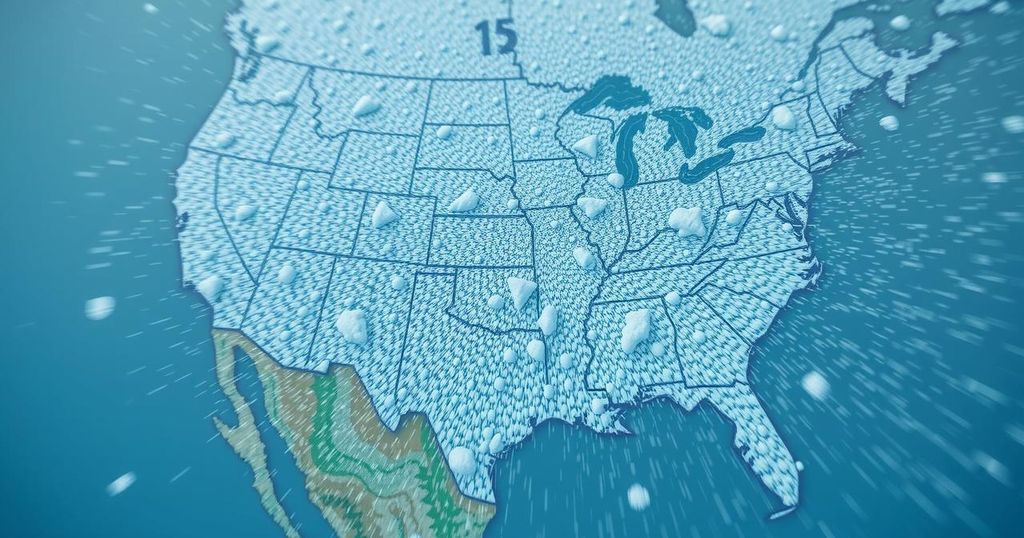Weather
95, AFRICA, ALBERTA, ALBERTA CLIPPER, ARI SARSALARI, BUFFALO, BURKINA FASO, CANADA, CHICAGO, CLEVELAND, DAKOTA, DAKOTAS, ERIE, FOX FORECAST, FOX WEATHER, FOX WEATHER METEOR, GAMEPLAY, GREAT LAKES, GREEN BAY, INTERSTATE 95, MINNEAPOLIS, NEW ENGLAND, NEW YORK, NEW YORK CITY, NONE, NORTH AMERICA, NORTH DAKOTA, NORTHEAST, OHIO, PA, PENNSYLVANIA, RAIN, RECREATION, SYRACUSE, TIER, UNITED STATES, WEATHER, WEATHER FORECAST
Ethan Kim
0 Comments
Alberta Clipper Set to Bring Significant Snowfall Across Over 12 States
An Alberta Clipper will bring snow and rain to over a dozen states from the Dakotas to the Northeast, starting Wednesday. Expected to affect areas with prior lake-effect snow, this fast-moving low-pressure system will traverse from North Dakota to New England by Thursday. The storm may yield several inches of snow in impacted regions, though New York City may see only light accumulation due to warmer temperatures.
A fast-moving low-pressure system, known as an Alberta Clipper, is set to traverse the northern United States beginning Wednesday, bringing snow and rain across more than a dozen states from the Dakotas to the Northeast. This system, which originates from Alberta, Canada, is expected to impact areas already experiencing significant lake-effect snow, such as Buffalo and Syracuse in New York, and Cleveland, Ohio.
The Alberta Clipper will start its journey in North Dakota, subsequently moving swiftly southeast towards the Great Lakes and the Northeast by Thursday. According to the FOX Forecast Center, several inches of snow may be added to regions inundated with prior snowfall. This fast-moving storm is not expected to be particularly strong, yet it will cover a wide area with snow.
Meteorologist Ari Sarsalari of FOX Weather explained, “The lake-effect snow that you’re looking at right here, that’s what we call mesoscale meteorology, something that’s happening on a small scale. What we have coming through a little bit later on this week is actually a bigger storm system. It’s a fast-mover. It’s not going to be very strong, but it’s a clipper, and it means that it’s going to dump snow over a pretty large area.”
As the Alberta Clipper approaches, areas like Erie, Pennsylvania, will continue to experience lake-effect snow through Tuesday, with additional snowfall expected on Wednesday and Thursday. Snow could also reach the Interstate 95 corridor in the Northeast; however, forecasters remain uncertain regarding the total accumulation due to varying temperatures.
Alongside snowfall, the storm may bring strong winds, resulting in wind chill factors that could make temperatures feel significantly colder in cities such as Minneapolis, Green Bay, Chicago, Cleveland, and Buffalo. In New York City, forecasters predict the potential for rain on Thursday with a slight chance of snow as the system exits. Meteorologist Jane Minar indicated, “We know the clippers are moisture-starved to begin with. Cold air is much denser. It’s drier. And so it takes a lot for a clipper to bring snow to New York City. You need the cold air in place.”
Consequently, while some snowflakes may fall in New York City, significant accumulation is unlikely given the expected warmer temperatures in the lower 40s.
In summary, the Alberta Clipper is anticipated to bring a swath of snow across over a dozen states from the Dakotas to New England, particularly affecting areas already dealing with snow from earlier storms. As the system proceeds into the Northeast, snowfall amounts and temperatures will dictate the impact, especially in metropolitan regions.
An Alberta Clipper is a type of storm system characterized by its rapid movement and ability to produce snow across large areas. Originating from Alberta, Canada, these systems usually bring cold air along with moisture, leading to snowfall predominantly in the northern states. The weather pattern is particularly significant during winter months, impacting various regions simultaneously, including those affected by lake-effect snow. Meteorologists assess the evolving conditions to forecast potential snowfall and the effects of accompanying winds and temperatures.
The impending Alberta Clipper is predicted to affect more than a dozen states from the Dakotas to New England, bringing additional snow to areas already burdened with previous snowfall. With strong winds and rapidly changing conditions anticipated, forecasters will continue to monitor temperature variations that could influence overall snowfall amounts, particularly in metropolitan areas where rain or snow may fall depending on local temperatures.
Original Source: www.foxweather.com




Post Comment